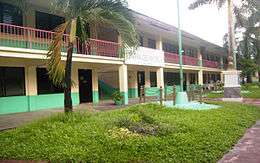Marikina Science High School
| Marikina Science High School Mataas na Paaralang Pang-Agham ng Marikina | |
|---|---|
|
Excellence, Discipline, Good Taste | |
| Address | |
|
Mayor Juan Chanyungco St., Sta. Elena Marikina City, Metro Manila Philippines | |
| Information | |
| Type | Public high school, science curriculum |
| Established | November 8, 2001 |
| Principal | Emily G. Santos |
| Grades | 7 to 12 |
| Number of students | 901 (SY 2015-2016) |
| Medium of language | English, Filipino, Nihongo, Mandarin |
| Campus | Rodriguez Building, TESDA (Main Campus) |
| Area | 3,100 sq. m. (approximate) |
| Color(s) | Golden yellow, blue |
| Nickname | MariSci, MSHS |
| Affiliations | Division of City Schools - Marikina |
The Marikina Science High School (Filipino: Mataas na Paaralang Pang-Agham ng Marikina), known as MSHS or MariSci, is a Philippine public science high school (a high school using the Special Science Curriculum) located at Mayor Juan Chanyungco Street, Sta. Elena, Marikina City. It is an offshoot of the Marikina Institute of Science and Technology which split up on November 9, 2001. The school's motto is "Discipline, Good Taste and Excellence". The current principal is Emily G. Santos, who will assume the position effective September 16, 2016, replacing Alberto D. Villamor.
History

Marikina Science High School was founded on 18 July 1947 as Marikina Junior High School through Municipal Council Resolution No. 59 s. 1947. This is done to jump start higher education in the town of Marikina, which was then under the administration of Gil Fernando. Fernando then became regarded as the "Father of secondary education" in Marikina, who worked together with Tomas L. Santos after World War II to recognize his integrity, eloquence and learning for the rehabilitation of schools.[1] In 1952, it changed its name to the Leodegario Victorino Memorial High School (LVMHS) in honor of Leodegario Victorino, former councilor of Marikina, Marikina School of Arts and Trades (MSAT) in 1957, and Marikina Institute of Science and Technology (MIST) in 1978. This is where Marikina Science High School traces its origin. On November 8, 2001, the secondary level was separated from Marikina Institute of Science and Technology, giving way to the establishment of what is now Marikina Science High School. Meanwhile, through Republic Act 9289, the college sector of MIST was renamed as Marikina Polytechnic College (MPC) in 2004.[2]
Principals
Since its foundation in 2001, six principals have served Marikina Science High School. The school's current principal is Emily G. Santos, who took office on September 16, 2016.
| 1 | Lauro Z. De Guzman | November 9, 2001 - August 20, 2009 |
| 2 | Edgardo L. Nieto | August 24, 2009 - July 4, 2010 |
| 3 | Albert B. Mutia | July 5, 2010 - June 11, 2012 |
| 4 | Victoria D. Naranja | June 12, 2012 - August 20, 2014 |
| 5 | Alberto D. Villamor | August 22, 2014 - September 15, 2016 |
| 6 | Emily G. Santos | September 16, 2016 - present |
Admission
Grade 6 students who are bona fide residents of Marikina City can take the entrance examination of the school.[3] The entrance test results and the interview results determine if the student is eligible for admission. Those who pass the examination and the interview, which tests reading comprehension, are eligible for admission. In 2011, the school system decided to remove the requirement for incoming students to have residency in Marikina. This opened the school to accepting residents from neighboring areas such as Quezon City, Pasig City, Antipolo, Cainta and San Mateo, Rizal. Students who plan to enroll should inquire at the school for details.
Curriculum
The school uses the weighted mean system in assessment of a student's academic performance. A unit value of 1.5 is given to the major subjects (math, science and english). A unit value of 1 is given to the minor subjects. A 0.5 unit is given to foreign language. A zero unit is given to HRO and Religious Instruction. This system was adopted in order to put emphasis and importance to the fields of study being focused on a specific year level.[4]
In 2012, the school complied to the K-12 education, the latest major change in national education in the Philippines, which added two years to secondary education.
Achievements
- Well-Managed School, Division of Marikina City: 2004, 2007[4]
- Division Secondary Schools Press Conference, Division of Marikina City: 1999-2010, 2012-2016 (first place), 2011 (second place)[5]
- Regional Schools Press Conference, National Capital Region: 2012 (fourth best school)
- Division of Marikina City Superintendent's Award recipient: 2014-2015 (CGO Initiative)
- Annual Reading Proficiency Contest, Regional Level: 1999, 2009, 2012 (first place)[5]
Notable alumni
- Bayani Fernando, former Chairman of the Metropolitan Manila Development Authority[6]
- John and Paul Herrera, fashion designers[5]
- Marcelino Teodoro, legislator for the 1st District of Marikina City[6]
References
- ↑ MARIKINA POLYTECHNIC COLLEGE History
- ↑ Zamboanga.com: Marikina Science High School
- ↑ MSHS Application Form. Retrieved 2010.
- 1 2 Marikina Science High School: Smart Schools Program
- 1 2 3 The Shoeland: The official school paper of the Marikina Science High School
- 1 2 Marikina Science High School|LVHS|MSAT|MIST|MariSci
